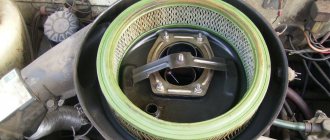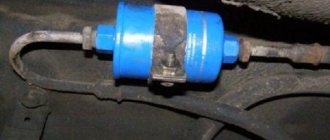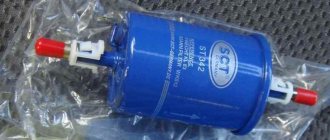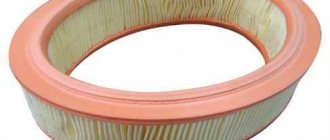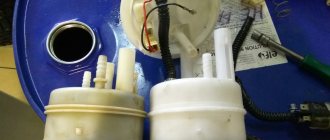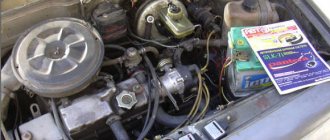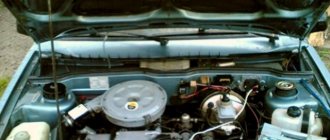Car tuning is interesting to almost every motorist. If external tuning is considered by many to be the domain of laymen, then tuning performed with the power unit evokes respect and a certain amount of envy from almost everyone.
A properly adjusted engine, with modified intake and exhaust systems, develops much more power. Accordingly, an increase in power requires an increase in air supply, so many craftsmen install a zero-resistance filter or simply a zero filter.
Owners of old engines started talking about it especially strongly, trying to tune the carburetor, thereby giving their car more mobility. We will try to explain in this article why we need a zero on a carburetor and what it gives.
Why do you need an air filter?
Absolute zero only occurs in space, and then only for a short time, and then it depends on where you’re counting from. And if the filter has no resistance, then what kind of filter is it then... But first things first. An air filter is necessary for any internal combustion engine, any compressor, in a word, any mechanism that consumes air. Especially in large quantities, especially in difficult temperature conditions. Of course, we are getting at the fact that a car engine, like no other mechanism, operates under extremely difficult and often unexpected conditions. It consumes a huge amount of air with a high content of solid silicon particles, which housewives call dust.
The Germans from the Sachs laboratory estimated that for every 100 European kilometers of the autobahn, a car swallows 60 grams of pure dust. Please think about this terrible figure. We take a stack of grated silicon, pour it into the intake manifold and start the engine. You get shivers down your spine when you think about how much dust our VAZ 2107 eats up, meandering around the Vologda region for 400 kilometers. Yes, some of the dust settles on the walls of the manifold, throttle body or in the labyrinths of the carburetor, but sooner or later it will get to the cylinder-piston group , will get into the oil and begin to eat the rubbing surfaces. In short, an air filter is necessary.
Installation Features
Many car enthusiasts make a big mistake - they install the “zero” incorrectly, which is why it is not able to perform its functions normally.
For example, the filter is installed too close to a hot engine or exhaust manifold. Here it’s time to remember physics.
The density of cold air is higher than that of hot air. As a result, it is easier to “push” cold air into the combustion chamber than hot air.
Therefore, the “nulevik” should be located as far as possible from any heat sources (motor, exhaust manifold, etc.).
In addition, it is not recommended to install the filter in the lower part of the engine compartment. In such a situation, the product will quickly become dirty and lose its best qualities.
In addition, a dirty filter will have to be “repaired”, which will also take some time.
Today there are a lot of models of zero filters that are designed for installation on various types of cars - with an injector or a carburetor.
The material can be mesh, foam rubber or cotton. Filters made of foam rubber have the highest degree of purification, but they also have more resistance than their “brothers”.
Installation of the “nulevik” on different cars is done differently, but in general you need to follow the following algorithm:
- discard the connector from the MAF (mass fuel flow sensor);
- use a screwdriver to disconnect the rubber tube from the air flow sensor;
- remove the sensor fasteners from the body (to do this you will have to unscrew a couple of bolts);
- dismantle the case and remove the rubber clamps (use duckbills or pliers);
- unscrew the fastener from the group of wires;
- fasten a pair of bolts from the mass air flow sensor clamp to the “zero” fastener;
- Place a new filter on the mass air flow sensor, tighten the clamping clamp and connect the sensor.
That's all, the new filter is installed on the car.
What is a zero resistance air filter
If we exclude the existence of dust in principle and feed the car with the cleanest air, remove all filters and barriers on the way of air to the combustion chamber, then the engine power will increase by 3-5%. This is the price we pay for installing an air filter, but if not for it, the engine would not be able to withstand tens of thousands of kilometers, if not less. It all depends on the operating conditions. Therefore, a filter is still needed.
It is easy to calculate that the increase in power is a miniscule amount. The engine spends much more energy to overcome aerodynamic drag. And its coefficient is greatly increased by ill-conceived body kits, spoilers and fairings. The point is not even in them, but in the fact that the design engineers of sports cars were puzzled by this problem, deciding to make a filter element that would create minimal resistance when sucking in air, and at the same time filter it from abrasive particles. At least for a short time, during the check-in period. The zero resistance filter is a racing car attribute.
Problems in the operation of the VAZ 2109 (carburetor) related to filters
It happens that the car starts to move jerkily. When checking the engine, nothing is found, but the malfunction is obvious. In such cases, you need to check the fuel filter.
It must be removed (do not lose the special O-ring). After which, the filter is washed with gasoline and purged under pressure.
If no problems are found, also check the additional filter. If it is faulty, it is better to simply replace it.
The Nine fuel filter can cause a lot of trouble for drivers
One more thing - check the oil in the air filter on the VAZ 2109 (carburetor). If oil was found in the air filter, you need to look at the condition of the oil scraper rings on your car. Measure the compression. This is usually the best way to determine the cause of trouble.
Advantages
The three percent of power that the installation of a zero filter gives is not determined by every stand, let alone a person while driving in normal conditions around the city. Therefore, the advantages of the nullik include:
- Increase engine power by 3-5%.
- Spectacular appearance during inspection and oil changes.
- Unconditional advancement in the ranking of the fastest cars in the neighborhood.
But this barrel of honey will also have to add a small fly in the ointment. The fact is that a cheap filter practically does not clean the air, but it creates resistance and also gets clogged. Therefore, it also needs to be changed, and much more often than a regular, standard filter. A good zero filter is enough for 3000 km at most, but no one measures the resources of bad handicraft filters. A good zero filter will only reach its service life if it is constantly treated with a special aerosol.
Advantages and disadvantages of “nuleviks”
As practice shows, such filters have their positive and negative qualities.
Let's start with the pros:
- increase in power by 5-7%. Of course, this may not be noticeable to the driver, but when installed in combination with other types of engine tuning, the result can be felt for yourself;
- changing the sound characteristics of the motor. It is believed that the filter element makes a special sound, which changes the general hum from the engine compartment. Many car enthusiasts install “nuleviks” precisely for this reason;
- The appearance of the space under the hood changes - it becomes more sporty.
Disadvantages of "nulevik":
- the need for constant maintenance, which not all car owners like to do;
- affordable filters are of low quality, so they clog almost immediately. The oil also becomes contaminated faster, which leads to a decrease in the life of the power unit.
Is a zero resistance filter necessary?
The economic side of the issue is already clearly limping on one leg, and if you take into account that if you neglect to skip the routine replacement of the filter, it will become clogged, as a result, the amount of air entering the combustion chamber will be less, fuel consumption will increase, and power will decrease. In addition, the characteristics of the gas distribution mechanism are calculated taking into account the stock filter, so failures and incorrect operation of the engine may occur at some speeds, and sometimes in each range. Hence the disadvantages of the zero filter:
- high operating price;
- small resource;
- unexpected changes in engine performance;
- increased fuel consumption.
A zero resistance filter is an excellent solution for a prepared engine, with a lot of changes when we are not talking about everyday use. The amount of power gain from applying certain modifications to the engine can give amazing results. Back in the late 70s, the outstanding Lithuanian racer Stasis Brundza removed about 200 horsepower from the VAZ 2106 engine. Of course, not with a cone whistle bought in a cheap store. Therefore, if the resource of the machine is more important, the nulevik can be screwed on as a decorative decoration. Tune your cars correctly, and have a good trip!
Is it worth installing a zero valve on a carburetor?
Of course, if you are tuning a carburetor, then installing a zero leveler is simply mandatory, because the advantages of using it are obvious:
- Power increases, while the quality of air purification does not deteriorate, which means the engine life ultimately increases;
- The question of regularly replacing the filter with a new one goes away, since the zero filter is simply washed;
- Increases torque at low and medium speeds.
However, the increase in power occurs in the range from 6 to 8%, which is not particularly noticeable on driving dynamics, and shelling out a considerable amount of money at once without resorting to other types of tuning is simply not advisable. Therefore, before you set a zero, think: do you need it?
How to make a zero filter with your own hands?
Some car enthusiasts, in a desire to save money, decide to make a “nulevik” with their own hands.
The source is a factory round filter, which was once installed on Moskvich cars.
To make a “nulevik” you can use different methods. We will describe one of them below.
You will need available tools (foam rubber, sealant, sharp knife, glue and others). The total price of the issue is no more than 3-4 US dollars.
It’s worth noting right away that a converted “zero” is unlikely to add power to your car. The reason is outdated technologies that were used in the production of cars in the 70-80s.
When creating filters, manufacturers thought little about the importance of cleaning, so old products only retain very large pieces of dirt. So, by “creating” a zero filter, you are taking a certain risk and can “kill” your engine.
By the way, the only car where such a zero filter would be “at home” is the Moskvich. At the same time, there are owners who immediately cut off the walls to eliminate excess flow resistance.
If you decide to experiment, the sequence will be as follows:
- remove the standard device;
- Make a rectangular adapter with a hole from a piece of plywood.
Drill four more holes and fix the adapter to the air meter sensor.
Before doing this, install a piece of pipe into the hole and treat the cracks with sealant;
- Make additional holes in two plywood circles. At the same time, make a hole of a larger diameter on the outer circle, and on the inner circle (installed near the air meter) - according to the diameter of the pipe being installed. The latter shrinks using sealant;
- make 3 bars with a length of about 16-18 centimeters and use them to fasten the circles. The result will be a unique cylindrical shape. Since there is no plywood in the bars, it is necessary to make holes along the edges for installing self-tapping screws (otherwise the plywood may be damaged);
- To prevent the foam from falling out, make a body. To make it, you can take a mesh for GVL joints. The advantage is the presence of a sticky base, which allows for immediate fixation;
- then foam rubber is glued on the outside using thermosealant, which allows you to securely and quickly fix the device;
- fix a couple of pieces of foam rubber for the side of the barrel with sealant;
- put on foam rubber and fasten the plywood beams with ties.
There are simpler solutions.
Is there any point?
It is a misconception that if you remove the air filter and its housing, the power will increase significantly. This is wrong. Engineers calculate the operation of the motor taking into account filter losses. From a practical point of view, an engine that gets caught in dust will not last long. A barrier in the form of an air filter is necessary. Flow resistance can be reduced by increasing the passage holes, i.e. slightly degrade the quality of filtration.
Remember: if the car does not have a sports engine, it is not advisable to spend several thousand rubles on a “zero”. Installing on a stock engine is just a beautiful thing under the hood.


